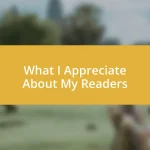Key takeaways:
- Engaging with reader emails provides unique insights, fosters connections, and reinforces the significance of writing as a shared experience.
- Reader feedback, both positive and negative, is essential for writing growth, offering direction, validation, and opportunities for community building.
- Strategies for reader engagement, such as personal responses and interactive polls, enhance the connection between the writer and their audience, enriching the creative process.

Introduction to Reader Emails
Reader emails have become an invaluable aspect of my journey as a writer. Each message reflects a unique perspective and often opens my eyes to new insights I hadn’t considered. Have you ever received a note that made you pause and rethink your approach? I have, and it’s those moments that truly enrich my understanding.
I remember one email that particularly struck a chord with me. A reader shared how a piece I wrote resonated with their personal struggles, and in their words, it felt like a lifeline. This connection not only highlighted the power of shared experiences but also reinforced my belief that writing is a two-way street. Don’t you find it fascinating how someone you’ve never met can feel so deeply connected to your thoughts?
Engaging with reader emails is like having a personal dialogue with each audience member. This interaction inspires me to keep writing authentically and reminds me that my words hold significance beyond the page. Each email is a gentle reminder that, as writers, we have the privilege—and responsibility—of touching lives through our stories.
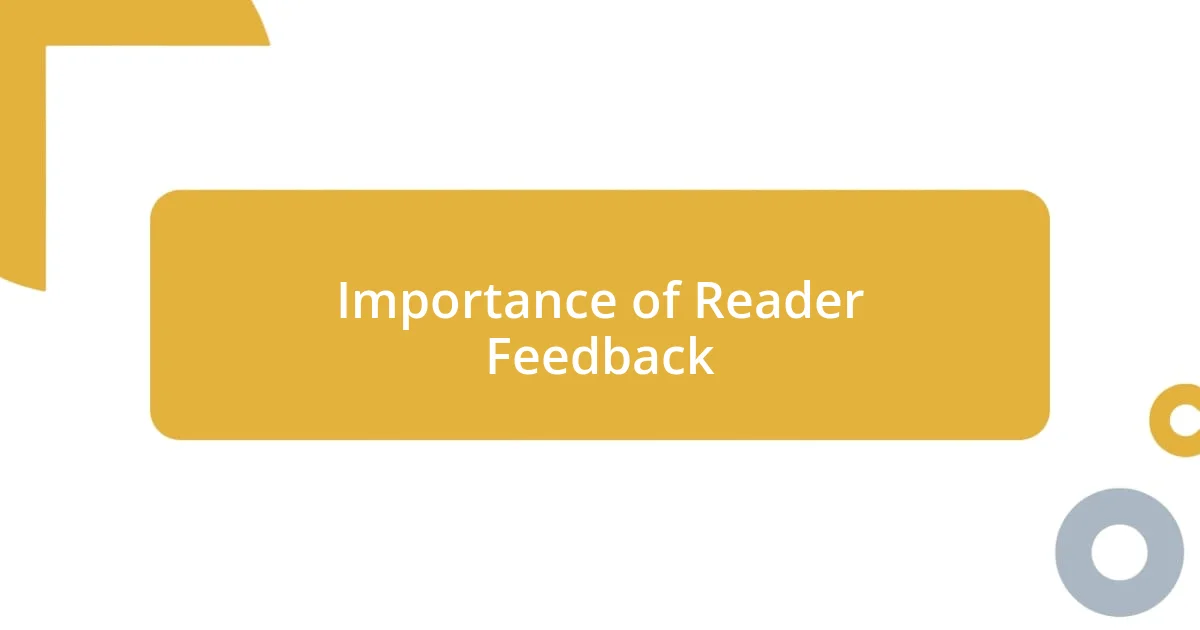
Importance of Reader Feedback
Reader feedback is an essential part of the writing process, acting as a mirror reflecting how my work resonates with others. Each email I receive not only provides validation but often sheds light on areas I may not have considered. For example, there was a time a reader pointed out the importance of including diverse perspectives in my writing. That simple suggestion expanded my horizons and improved my content significantly.
I can’t overstate how reader feedback can guide the evolution of my writing. Recently, I received an email from someone who expressed that a particular article helped them tackle a challenging situation they were facing. Their words helped me realize that my writing can be a source of support. It reinforces my belief that honing in on what my readers find valuable is crucial for growth.
The emotional connection I forge through these interactions is profound. One reader shared how my story about overcoming self-doubt motivated them to pursue their dreams. Such instances remind me that feedback is not just about critique; it’s also about building a community grounded in empathy and understanding. It truly allows me to write with intention, knowing my words can inspire action and change.
| Aspect | Impact of Reader Feedback |
|---|---|
| Validation | Provides affirmation and encouragement for continued writing. |
| Guidance | Offers direction on how to improve and adapt my writing style. |
| Connection | Builds a sense of community between me and my readers. |
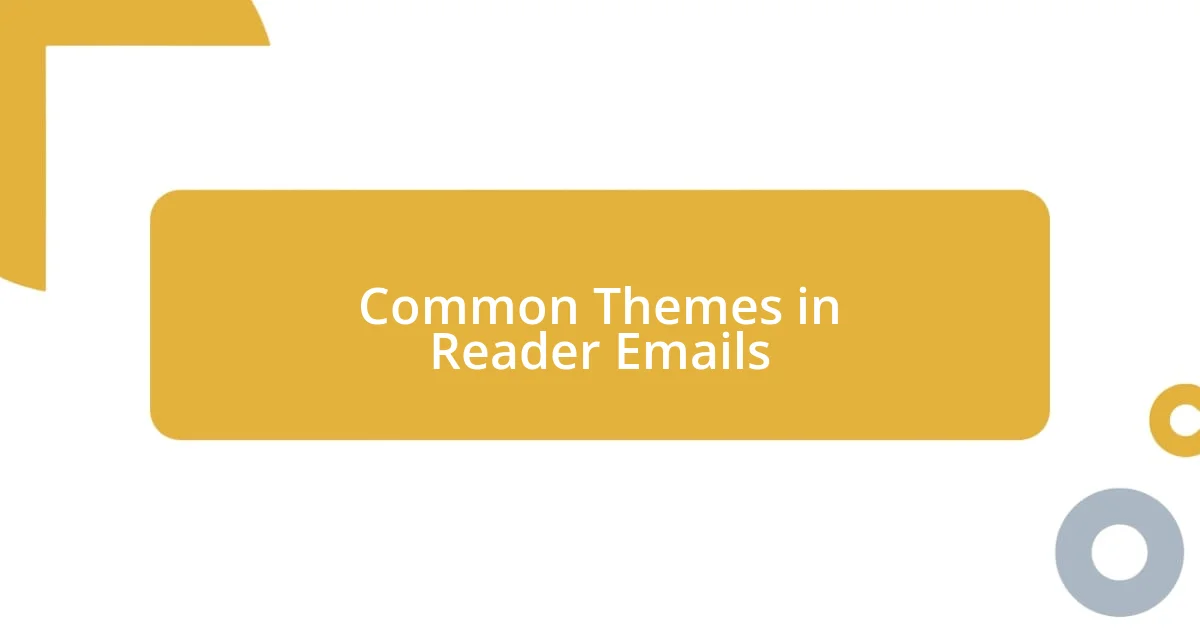
Common Themes in Reader Emails
Reader emails often reveal common themes that highlight both shared experiences and unique perspectives. I’ve noticed that many readers express feelings of gratitude, with messages that warm my heart and motivate me to write more authentically. For instance, one reader shared how my piece about mental health challenges resonated deeply with them, reflecting their own journey. This connection is not just inspiring—it’s a potent reminder of the impact we can have on one another through the written word.
Here are some recurring themes I’ve discovered in reader emails:
- Gratitude: Many readers express how a specific article helped them through tough times.
- Personal Connections: Readers often share personal stories that align with the topics I cover.
- Desire for More: Some emails include requests for deeper dives into certain subjects or related topics.
- Diverse Perspectives: A number of readers emphasize the importance of inclusivity in writing, prompting me to explore different viewpoints.
The emotional depth revealed in these messages underscores a vital aspect of writing: the ability to foster connections. It’s truly enlightening to hear how my words resonate with readers, making it clear that writing has the power to bridge gaps between our varied experiences.

Lessons from Positive Reader Responses
Receiving positive responses from readers often provides unexpected lessons. For instance, I once received an email from a young writer who stated that my advice on overcoming writer’s block transformed her approach to creativity. Her gratitude wasn’t just flattering; it reminded me that my experiences could resonate at different stages of someone’s journey, making my writing all the more worthwhile.
One insightful take-away has been the sheer power of storytelling. A reader shared how my personal anecdotes about failure made her feel less isolated in her struggles. It’s moments like these that lead me to wonder: how can our stories foster deeper connections? I’ve learned that sharing vulnerabilities can be a catalyst for building trust and community among readers.
Sometimes, these positive interactions encourage me to stretch beyond my comfort zone. After a series of uplifting emails from readers wanting more content on resilience, I decided to explore this theme more deeply in future articles. It makes me think, how do we evolve as writers without the feedback of those we aim to serve? Grasping these insights energizes my writing process, reminding me that I’m not just putting words on a page, but rather, weaving a tapestry of shared human experience.
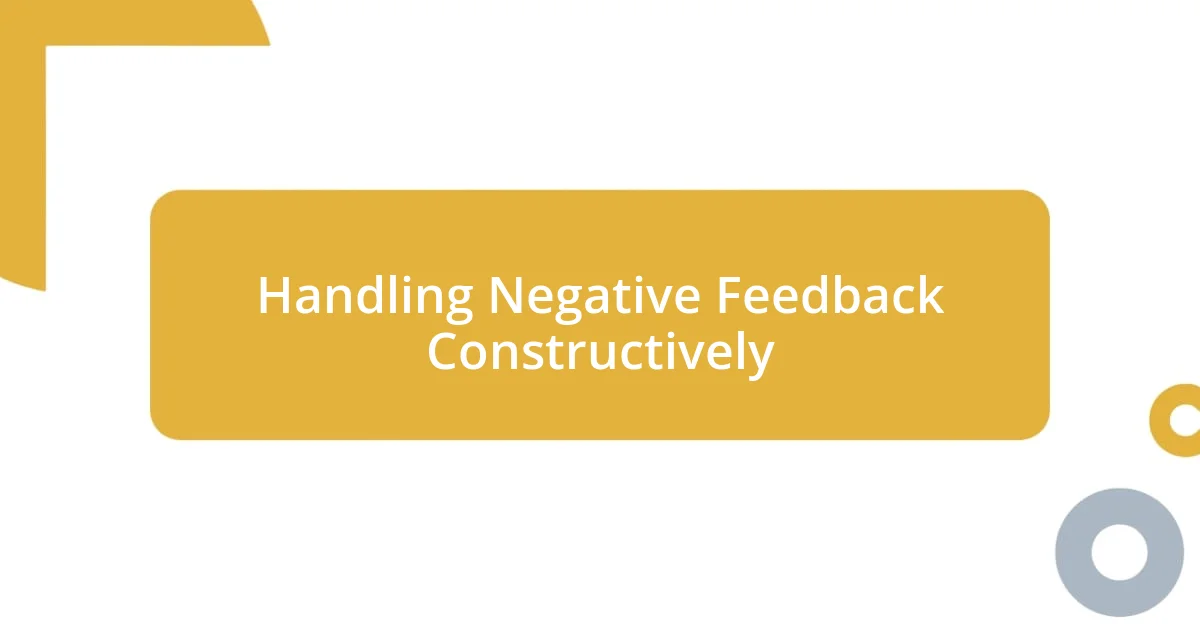
Handling Negative Feedback Constructively
Handling negative feedback can be challenging, yet I’ve found it to be an invaluable aspect of growth. One time, I received an email that critiqued my perspective on a sensitive topic; at first, I felt defensive. But after reflecting on the feedback, I realized this reader’s perspective offered insights I had overlooked. This experience taught me to view criticism not as an affront, but as a potential learning opportunity.
Sometimes, the emotions that come with negative feedback can cloud my judgment. I remember grappling with an email that pointed out factual inaccuracies in an article. Initially, I felt embarrassed and disheartened. However, I paused to appreciate that this reader cared enough to inform me. That moment shifted my perspective completely. It reminded me that constructive criticism is often rooted in a desire for clarity and improvement, which is a gift in any creative process.
I often ask myself, how can I turn negativity into a stepping stone for progress? Engaging with these critiques has led me to refine my writing style and clarify my messages, transforming stumbling blocks into stepping stones. Exploring these moments reminds me that vulnerability in sharing and receiving feedback fosters deeper understanding, benefiting both myself as a writer and my readers.
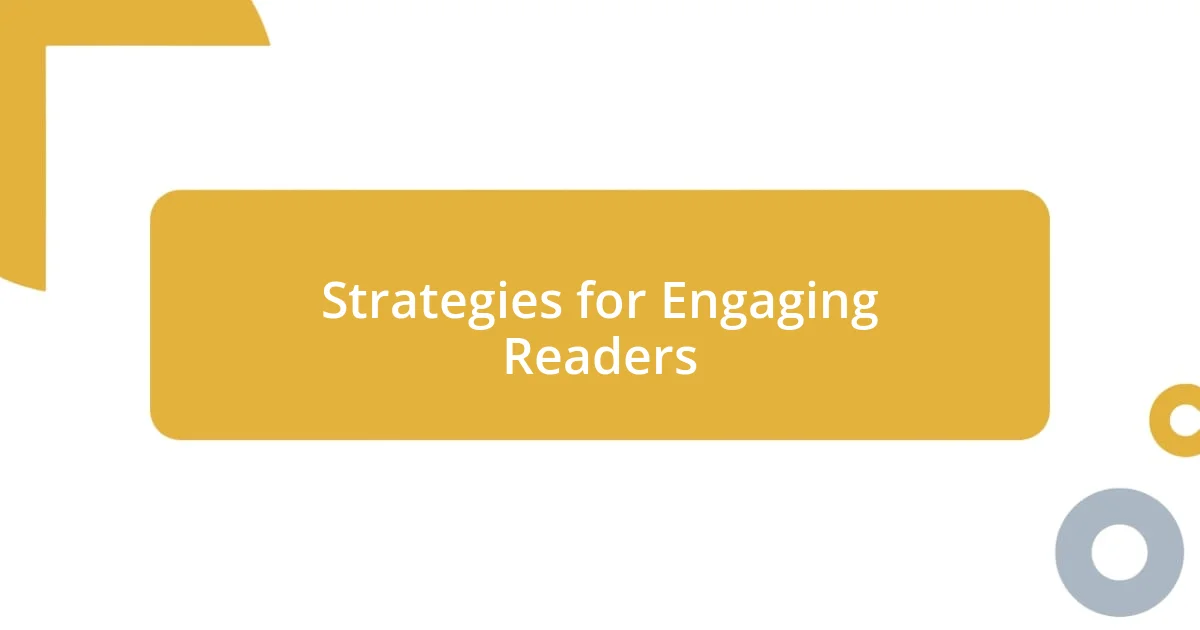
Strategies for Engaging Readers
Engaging readers requires a thoughtful approach, and one strategy I’ve found invaluable is creating a dialogue. When I receive emails, I make it a point to respond personally to as many as I can. In one instance, a reader shared their struggle with creativity during tough times. Instead of just thanking them, I asked follow-up questions to learn more about their experience, sparking a meaningful exchange. This not only deepened my connection with them but also provided fresh insights that I could incorporate into my writing.
Another effective strategy is using reader polls or questions at the end of my articles. One time, I posed a question about how my readers overcame challenges, inviting them to share their stories. The responses flooded in, rich with diverse experiences and perspectives. I realized that by inviting input, I not only keep my content relevant and relatable, but I also empower my readers to take an active role in our shared community. Isn’t it fascinating how engaging others can enrich our own understanding and creativity?
Lastly, incorporating visuals or personal stories that resonate with my audience helps maintain their interest. I remember sharing a photo from a significant moment in my writing journey and asking readers if they had similar experiences. It sparked a wave of responses filled with their stories. This taught me that when we share pieces of ourselves—be it through visuals or narratives—we create an inclusive space where readers feel valued and inspired to connect. How can we utilize these strategies to make our writing a two-way street, fostering not just engagement but genuine community?

Conclusion and Future Outlook
As I reflect on my experiences with reader emails, I realize that each message shapes my perspective and drives my growth as a writer. Every suggestion or critique brings with it a wealth of insights that not only enrich my content but also strengthen my connection with my audience. I can’t help but wonder: How can I continue to turn these interactions into transformative experiences for both myself and my readers?
Looking ahead, I feel excited about the potential for deeper engagement with my audience. I envision creating more interactive formats, such as live Q&A sessions, where readers can share their thoughts in real-time. This idea stems from my joy in connecting with individuals during past events, where their excitement and passion inspired me to explore new avenues in my writing. Isn’t it incredible how collaboration can amplify creativity in such enriching ways?
Ultimately, my journey with reader emails has taught me that every message, whether praise or criticism, is a stepping stone towards improvement. I’m eager to keep this dialogue alive, inviting readers to share their stories and insights with me in the future. One thing I know for sure is that by embracing this exchange, we can cultivate a vibrant community that elevates each voice and enhances the creative process. How will our collective experiences shape the next chapter of our journey together?













